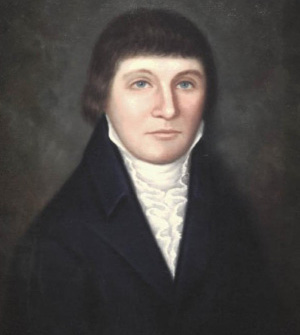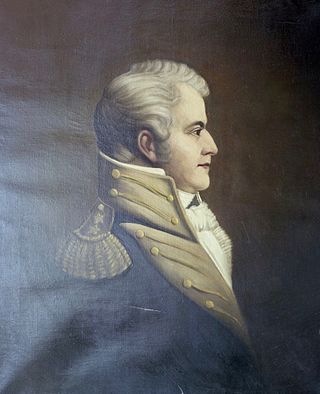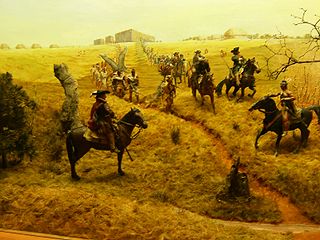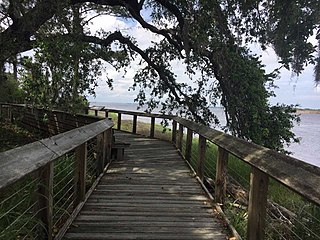Related Research Articles
Francis Nash was a slave owner and brigadier general in the Continental Army during the American Revolutionary War. Prior to the war, he was a lawyer, public official, and politician in Hillsborough, North Carolina, and was heavily involved in opposing the Regulator movement, an uprising of settlers in the North Carolina piedmont between 1765 and 1771. Nash was also involved in North Carolina politics, representing Hillsborough on several occasions in the colonial North Carolina General Assembly.

Lieutenant-General William Tryon was a British Army officer and colonial administrator who served as governor of North Carolina from 1764 to 1771 and the governor of New York from 1771 to 1777. He also served during the Seven Years' War, the Regulator Movement, and the American War of Independence.

Richard Caswell was an American politician and lawyer who served as the first and fifth governor of the U.S. state of North Carolina from 1776 to 1780 and from 1785 to 1787. He also served as a senior officer of militia in the Southern theater of the American Revolutionary War. As a delegate to the First Continental Congress, he was a signatory of the 1774 Continental Association.

Benjamin Smith was the 16th governor of North Carolina from 1810 to 1811.

John Baptist Ashe was an American politician and military officer from Halifax, North Carolina.

Robert Howe was a Continental Army general from the Province of North Carolina during the American Revolutionary War. The descendant of a prominent family in North Carolina, Howe was one of five generals, and the only major general, in the Continental Army from that state. He also played a role in the colonial and state governments of North Carolina, serving in the legislative bodies of both.

James Moore Sr. was a military officer and colonial administrator who served as the governor of Carolina from 1700 to 1703. He is best known for leading several invasions of Spanish Florida during Queen Anne's War, including attacks in 1704 and 1706 which wiped out most of the Spanish missions in Florida. He captured and brought back to Carolina as slaves thousands of Apalachee.
Edward Moseley, was a British colonial official who served as the first public treasurer of North Carolina from 1715 until his death in July 1749). He previously served as the surveyor-general of North Carolina before 1710 and again from 1723 to 1733. Moseley was also responsible, with William Byrd of Virginia, for surveying the boundary between North Carolina and Virginia in 1728.

The Battle of Moore's Creek Bridge was a minor conflict of the American Revolutionary War fought near Wilmington, North Carolina, on February 27, 1776. The victory of the North Carolina Provincial Congress' militia force over British governor Josiah Martin's and Tristan Worsley's reinforcements at Moore's was a turning point in the war; American independence was declared less than five months later.
The 1st North Carolina Regiment of the Continental Army was raised on September 1, 1775, at Wilmington, North Carolina. In January 1776 the organization contained eight companies. Francis Nash was appointed colonel in April 1776. The regiment was present at the defense of Charleston in 1776. It transferred from the Southern Department to George Washington's main army in February 1777. At that time, Thomas Clark became colonel of the 1st Regiment. The regiment became part of General Francis Nash's North Carolina Brigade in July.
John Ashe, Sr. was Speaker of the House of Burgesses in the Province of North Carolina. He was Harvard educated and fought in the North Carolina militia during the French and Indian War. During the American Revolution, he attained the rank of major general and was in charge of North Carolina militia and state troops from 1776 to 1779. He resigned from military service after the Patriot defeat at the Battle of Brier Creek in 1779.
Nathaniel Rice was a British colonial administrator who served as the acting governor of North Carolina in 1734 and from 1752 to 1753.
James Moore was an American military officer who served in the Continental Army during the American Revolutionary War. Moore was born into a prominent political family in the colonial Province of North Carolina, he was one of only five generals from North Carolina to serve in the Continental Army. He spent much of his childhood and youth on his family's estates in the lower Cape Fear River area, but soon became active in the colonial military structure in North Carolina.

The Orton Plantation is a historic plantation house in the Smithville Township of Brunswick County, North Carolina, United States. Located beside the Cape Fear River between Wilmington and Southport, Orton Plantation is considered to be a near-perfect example of Southern antebellum architecture. Built in 1735 by the co-founder of Brunswick Town, Colonel Maurice Moore, the Orton Plantation house is one of the oldest structures in Brunswick County. During its history Orton Plantation has been attacked by Native Americans, used as a military hospital, and been home to lawyers, physicians, military leaders, and a Colonial governor.

Brunswick Town was a prominent town in colonial North Carolina. It was the first successful European settlement in the Cape Fear region, a major colonial port in the 18th century, and home to two provincial governors. Brunswick Town existed for 50 years until it was burnt in a 1776 raid by British forces during the American Revolutionary War and never rebuilt. During the American Civil War, 86 years after the town was abandoned, a large portion of the town was covered by earthworks for the construction of Fort Anderson.

Alfred Moore was an American judge, lawyer, planter and military officer who became an associate justice of the Supreme Court of the United States. Moore Square, a park located in the Moore Square Historic District in Raleigh, North Carolina, was named in his honor, as was Moore County, North Carolina. He was also a founder and trustee of the University of North Carolina at Chapel Hill.

General Hugh Waddell was an Irish-born military officer, merchant, planter and politician who served in the Thirteen Colonies during the mid-18th century. Waddell formed and led a provincial militia unit in Rowan County, North Carolina and the Ohio River Valley during the French and Indian War and the Anglo-Cherokee War, and supervised the construction of Fort Dobbs near the settlement of the Fourth Creek Congregation. His career was well-served by close connections to several provincial governors of North Carolina.
The Province of Georgia was a significant battleground in the American Revolution. Its population was at first divided about exactly how to respond to revolutionary activities and heightened tensions in other provinces. Georgia was the only colony not present in the First Continental Congress in 1774. When violence broke out in 1775, radical Patriots took control of the provincial government, and drove many Loyalists out of the province. Georgia subsequently took part to the Second Continental Congress with the other colonies. In 1776 and 1778, Georgia served as the staging ground for several important raids into British-controlled Florida. The British army captured Savannah in 1778, and the American and French forces failed to recapture the city during the Siege of Savannah in 1779. Georgia remained under British control until their evacuation from Savannah in 1782.

The Battle of Alamance, which took place on May 16, 1771, was the final confrontation of the Regulator Movement, a rebellion in colonial North Carolina over various issues with the Colonial Government. The Regulators primarily wanted reforms to the currency act and to stop local corruption. They will also request other changes, like secret ballot voting, progressive taxation, land reform, and more transparent government. Named for nearby Great Alamance Creek, the battle took place in what was then Orange County and has since become Alamance County in the central Piedmont area, about 6 miles (9.7 km) south of present-day Burlington, North Carolina.

Thomas Polk was a planter, military officer in the Continental Army during the American Revolutionary War from 1775 to 1781, and a politician who served in the North Carolina House of Commons, North Carolina Provincial Congress, and Council of State. Polk commanded the 4th North Carolina Regiment in the Battle of Brandywine. In 1786, Polk was elected by the North Carolina General Assembly to the Congress of the Confederation, but did not attend any of its sessions. Polk was a great-uncle of the 11th President of the United States, James K. Polk.
References
- ↑ Heitzler, Michael James (2005). Goose Creek, A Definitive History: Volume One, Planters, Politicians and Patriots. The History Press. p. 275. ISBN 978-1-59629-055-6 . Retrieved 8 October 2011.
- ↑ Lewis, J.D. (2007). "Carolina Governors - James Moore, Sr". carolana.com. Retrieved 12 August 2024.
- ↑ "Tilney Coachman". 17 May 2009. Retrieved 12 August 2024.